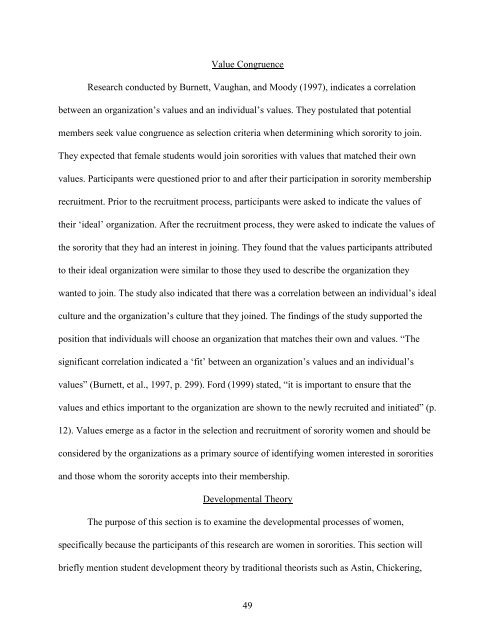Sorority Rituals - Reflections On Rites of ... - Mari Ann Callais
Sorority Rituals - Reflections On Rites of ... - Mari Ann Callais
Sorority Rituals - Reflections On Rites of ... - Mari Ann Callais
Create successful ePaper yourself
Turn your PDF publications into a flip-book with our unique Google optimized e-Paper software.
Value Congruence<br />
Research conducted by Burnett, Vaughan, and Moody (1997), indicates a correlation<br />
between an organization’s values and an individual’s values. They postulated that potential<br />
members seek value congruence as selection criteria when determining which sorority to join.<br />
They expected that female students would join sororities with values that matched their own<br />
values. Participants were questioned prior to and after their participation in sorority membership<br />
recruitment. Prior to the recruitment process, participants were asked to indicate the values <strong>of</strong><br />
their ‘ideal’ organization. After the recruitment process, they were asked to indicate the values <strong>of</strong><br />
the sorority that they had an interest in joining. They found that the values participants attributed<br />
to their ideal organization were similar to those they used to describe the organization they<br />
wanted to join. The study also indicated that there was a correlation between an individual’s ideal<br />
culture and the organization’s culture that they joined. The findings <strong>of</strong> the study supported the<br />
position that individuals will choose an organization that matches their own and values. “The<br />
significant correlation indicated a ‘fit’ between an organization’s values and an individual’s<br />
values” (Burnett, et al., 1997, p. 299). Ford (1999) stated, “it is important to ensure that the<br />
values and ethics important to the organization are shown to the newly recruited and initiated” (p.<br />
12). Values emerge as a factor in the selection and recruitment <strong>of</strong> sorority women and should be<br />
considered by the organizations as a primary source <strong>of</strong> identifying women interested in sororities<br />
and those whom the sorority accepts into their membership.<br />
Developmental Theory<br />
The purpose <strong>of</strong> this section is to examine the developmental processes <strong>of</strong> women,<br />
specifically because the participants <strong>of</strong> this research are women in sororities. This section will<br />
briefly mention student development theory by traditional theorists such as Astin, Chickering,<br />
49



